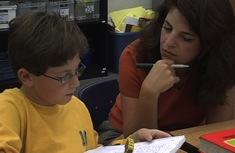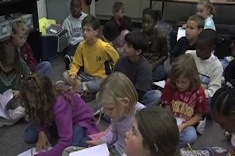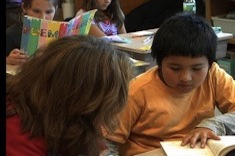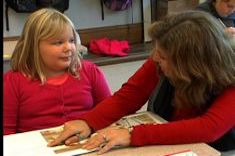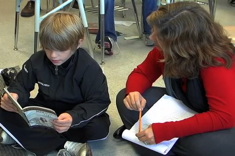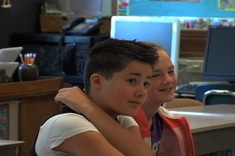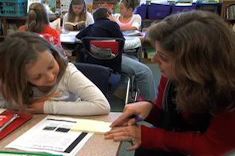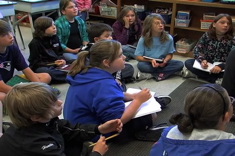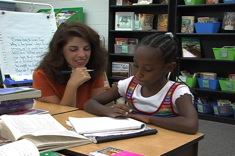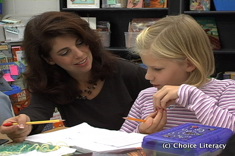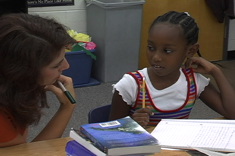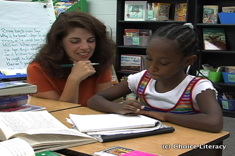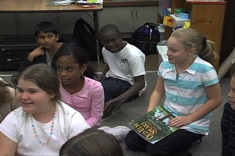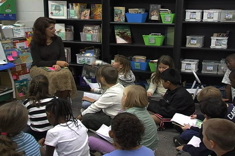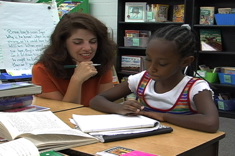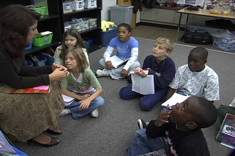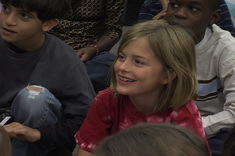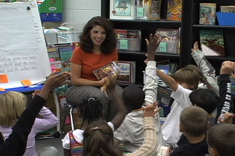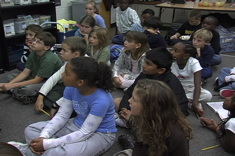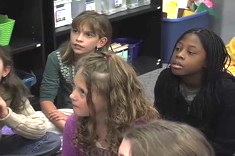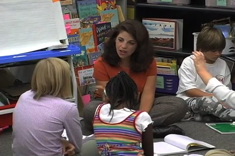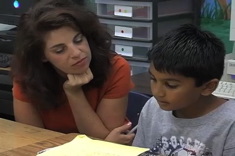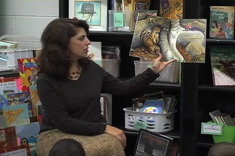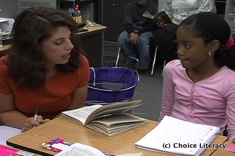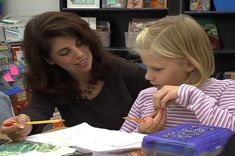Aimee Buckner
Aimee Buckner has been in the teaching profession for over 20 years. She has taught upper elementary and middle school students. Aimee also has facilitated groups for various writing institutes for teachers and students of grades K-12. She speaks professionally at state and national conferences, as well as within school districts. Aimee’s books Notebook Know-How and Notebook Connections are both available through Stenhouse.
Latest Content
Conferring: Establishing a Setting in a Novel
In this week's video, Aimee Buckner has a quick conference with a fourth grader about ways to solve a dilemma — how to figure out the setting in a historical fiction novel when there are no pictures.
Beginning a Novel with Close Reading
Aimee Buckner helps a fourth-grade boy tease out emerging themes in the first pages of the novel Morning Girl.
Notebook Sketching: Conferring with Sarah
Aimee Buckner confers with Sarah about sketching in her notebook.
Fluency and Comprehension Conference
Aimee Buckner confers with fourth grader Amanda about her reading comprehension and fluency, encouraging her to use a sticky note to track thinking around a focus question.
Fourth-Grade Reading Conference: Focusing While Reading
Aimee Buckner helps fourth grader Isaiah focus his reading early in the year in this quick conference.
Conferring About Lemony Snicket and Vocabulary
Aimee Buckner confers with fourth grader Samantha about reading a series and tackling challenging vocabulary at the same time in this brief video.
Tracking Characters: A Conferring Tip
Aimee Buckner teaches a fourth grader a strategy for using a sticky note to keep track of characters when there are multiple narrators in a novel.
Independent Reading By the Numbers Is NOT Text Complexity
How do you guide students to select books for independent summer reading? Aimee Buckner challenges teachers who are requiring middle students to pick books based solely on Lexile scores.
Just Write More
Aimee Buckner has tips for ways to focus lessons that will help students produce more writing.
Teaching the Rule of Three to Writers
Aimee Buckner finds that teaching the rule of three to young writers adds variety to student texts.
Conferring, Rereading, and Comprehension
Aimee Buckner confers with Brendan, who is rereading Hoot and needs some strategies for holding his thinking.
From Reading to Writing Informational Texts
Aimee Buckner makes some surprising discoveries about what types of texts support writers working in nonfiction genres.
The Blank Page and Better Teaching
Aimee Buckner learns some important lessons about how images and words work together for student writers when she moves between second- and fifth-grade classrooms.
When Are Students Ready for Writers’ Notebooks?
Second grade? Third grade? Aimee Buckner breaks down what behaviors to look for if you’re trying to determine when students are ready to move from draft pages or booklets to writers’ notebooks.
Conferring for Engagement: First Steps
Aimee Buckner confers with a fourth grader who is learning how to choose books for independent reading. In this video, she gives advice in the first conference and then returns 10 minutes later for a follow-up meeting.
Conferring About Tracking Characters
In this video from a 4th grade classroom, Aimee Buckner confers with a student who is reading The Other Side by Jacqueline Woodson.
The Five-Minute Solution: Mini-Groups after Minilessons to Maximize Conferring Time
Aimee’ Buckner’s mini-groups are an easy and simple way to differentiate instruction in workshops, and save time when conferring.
Narrative Nonfiction in 5th Grade Part 2
In this lesson from a 5th grade classroom, Aimee Buckner guides students in a note-taking process to help understand the qualities of nonfiction narrative writing. In this second part of the lesson, students share their notes and Aimee makes connections to additional mentor texts.
Stop and Track: Conferring with a Fifth-Grade Reader
In this conference with a 5th grader, Aimee Buckner shares two strategies — one to use when putting a book away between readings, and another to help keep track of characters in a complex narrative where the point of view is constantly shifting.
Scaring Up Better Narratives Part I
Just before Halloween, Aimee Buckner leads a lesson on brainstorming topics in writer's notebooks using the mentor text Some Things Are Scary. In this first installment of a three-part series, Aimee reads the book and models her own thinking process and use of a writer's notebook.
Scaring Up Better Narratives Part 2
Just in time for Halloween, Aimee Buckner leads a lesson on brainstorming topics in writer's notebooks using the mentor text Some Things Are Scary. In this second installment of a three-part series, Aimee continues to confer with students and helps everyone refine potential writing topics in their notebooks.
Scaring Up Better Narratives Part 3
Aimee Buckner leads a lesson on brainstorming topics in writer's notebooks using the mentor text Some Things Are Scary. In this final installment of a three-part series, Aimee continues to confer with students and shares a great tip for nonfiction research.
Main Ideas, Summaries, and Notes in a Reading Conference
In this conference with a fourth grader, Aimee Buckner tackles text choice, notes, and main ideas all in less than five minutes. You’ll notice teachers observing in the background; the conference is part of a demonstration lesson sequence.
Conferring About Rereading Strategies
In this conference with a fourth grader, Aimee Buckner guides a child to think more deeply and critically about a book being read to the whole class, Goblins in the Castle.
Setting the Stage for Historical Fiction
In this demonstration lesson from a fifth-grade classroom, Aimee Buckner works with students to construct an anchor chart for understanding the genre of historical fiction.
Making the Reading-Writing Connection with Genre Studies: The “Must Have” Lesson
No stranger to genre studies, Aimee Buckner has both advice and book basket ideas to get must-haves in your hands.
Mentor Texts for Organizing Writing
We think of mentor texts for teaching literary elements, but what about for organizing? Aimee Buckner describes how she selects books to demonstrate a range of ways to organize writing and help students make choices independently.
Writing Better First Drafts
Aimee Buckner uses her love of baking to make the point that creating better first drafts is key to stronger writing and more enjoyment in the revising phase.
A Drive Through Assessment of My Writing
While considering some driving habits she's developed, Aimee Buckner shares what she's learned from the experts about writing and what it means to her practice.
Writers, Choice and Independence (Part I)
What does true independence look like among young readers and writers? A chance comment from a visitor to Aimee Buckner's classroom gets her pondering the amount of choice children have during units of study.
Writers, Choice and Independence (Part II)
In this second installment of a two-part series, Aimee Buckner writes about the value of open choice writing units.
Choosing Mentor Texts for Reading
In this quick take video, Aimee Buckner explains her criteria for selecting mentor texts for small-group, individual, and whole-class instruction.
Quick Take: Time Constraints in Conferences
In this two-minute video, Aimee Buckner explains how she deals with time constraints when she is conferring with students.
New Notebook Essentials
We’ve all had the experience of reading a professional book and disagreeing with some of the ideas from the author. It’s just a little more surreal when you wrote the book! Aimee Buckner participates in her school’s study group reading of Notebook Know-How, and finds some of her thinking about notebooks has changed over the past few years.
Quick Take: Selecting Mentor Texts for Writing Instruction
In this two-minute video, Aimee Buckner explains how she selects mentor texts for writing, as well as the importance of using writing by students and teachers in lessons.
When Do I Launch the Writer’s Notebook?
When and how should you launch writers' notebooks in your classroom? According to Aimee Bucker, it depends on if you are a "wader" or a "diver." She shares some of the ways she has slowly and quickly moved students into their notebooks in years past.
What Goes in the Writer’s Notebook?
Aimee Buckner chats with colleagues about notebooks, and finds herself rethinking what she puts in her notebook (as well as what she requires of students).
Using Poetry to Promote Reading Fluency
Aimee Buckner shares how to use a mentor text to build fluency through poetry.
Teaching Themes Through Keywords
Aimee Buckner presents a simple strategy for helping students look for themes as they read a new text.
Old Elm Speaks Conclusion: Connecting Poetry, Observation, and Reading
In this second installment of a three-part video series, Aimee Buckner shows how observation skills, poetry, and reading instruction come together with the mentor text Old Elm Speaks by Kristin O'Connell George. In this final excerpt, students share what they wrote after browsing the book and completing some observations.
Learning Curves and Dips: Planning and Goal-Setting for Writing Workshop
Aimee Buckner describes a simple summer planning and goal-setting process she uses to get ready for launching writer's workshop in the fall.
4th Grade Room Tour
In this video tour of her 4th grade classroom, Aimee Buckner highlights how she arranges books, charts, and other resources to support the reading and writing of her students.
4th Grade Small Group: Writing Paragraphs
In this video, Aimee Buckner uses a mentor text to demonstrate how writers construct lively nonfiction paragraphs.
4th Grade Small-Group Lesson: Dialogue
One of the challenges of working with intermediate writers is helping them understand how and when to use dialogue in their writing. In this video of a small-group lesson, Aimee Buckner uses a mentor text and a metaphor to help her 4th grade students understand the value of using dialogue sparingly in their writing.
Old Elm Speaks: Connecting Poetry, Observation, and Reading
In this first installment of a three-part video series, Aimee Buckner shows how observation skills, poetry, and reading instruction come together with the mentor text Old Elm Speaks by Kristin O’Connell George.
Old Elm Speaks Day 2: Connecting Poetry, Observation, and Reading
In this second installment of a three-part video series, Aimee Buckner shows how observation skills, poetry, and reading instruction come together with the mentor text Old Elm Speaks by Kristin O'Connell George.
Teaching Rereading During Class Read Alouds
Aimee Buckner teaches her fourth graders the power of rereading using the mentor text Goblins in the Castle by Bruce Coville.
Teaching Rereading Strategies Through Read Aloud Day 2
Aimee Buckner uses rereading as a strategy to deepen student understanding during read alouds.
From Questions to Drafts
Aimee Buckner shares the mentor text Could You? Would You? with her 4th grade students. Aimee explains how questions are a springboard to interesting writing topics, and models connections she makes to the text.
A Literacy “Playground”: Cheryl Cole’s Second Grade Classroom
Aimee Buckner hosts this video tour of Cheryl Cole’s second grade classroom at Brookwood Elementary School in Gwinnett County, Georgia. Cheryl shares the many strategies she uses to promote literacy learning in a warm, friendly environment.
Rule of 3: Writer’s Craft Whole-Class Lesson
Aimee Buckner teaches her fourth-grade students about the “Rule of 3” in writing.
Rule of 3: Mini-Group After Whole-Class Lesson
In this second video of a three-part series showing a teaching progression for the Rule of 3, Aimee Buckner has asked students who might want a little more information or help after the whole-class lesson to stay for a small group.
Rule of 3: Conferring
In this final video of a three-part series showing a teaching progression for “Rule of 3,” Aimee Buckner confers with individual students during writing workshop, checking in to see how they are applying the concept to their writing.
Listing Strategy: Minilesson
Aimee Buckner presents a listing strategy minilesson in writing workshop.
Narrative Nonfiction in Fifth Grade, Part 1
In this lesson from a fifth-grade classroom, Aimee Buckner guides students in a notetaking process to help them understand the qualities of nonfiction narrative writing.
Guilty Pleasures
Aimee Buckner reveals her guilty pleasures, and finds they make for great writing fodder.
Getting Started with Your Own Writer’s Notebook
Notebook Faker Extraordinaire Aimee Bucker writes about how she managed after years of false starts to build the writer's notebook habit one summer not long ago.
Power Tools
Aimee Buckner shares three essential "power tools" for writers.
Mentor Texts and Teacher Modeling: The Listing Strategy
In this video from her fourth-grade classroom, Aimee Buckner teaches the “listing” strategy, using the book This Is the Tree: A Story of the Baobab as a mentor text. Aimee talks about mentor texts, using her own writing as a model, and the needs of intermediate readers and writers during the lesson and interview.
A Strategy Lesson for “Drive-Thru” Readers
Who is a “drive-thru” reader? One who zips through the start of a book and discards it before finishing, moving ever more quickly through random books. Aimee Buckner has some minilesson suggestions for dealing with those students who can’t or won’t finish any books they start.
Writer’s Workshop: Planning for “Dips”
We love seeing growth, but how can we plan for plateaus or even dips with young writers? Aimee Buckner finds it's all about commitment.
Teaching Rereading During Class Read Alouds
Aimee Buckner teaches her 4th graders the power of rereading using the mentor text Goblins in the Castle by Bruce Coville.
Browse Content By
Type
Category
- Assessment Tools
- Big Fresh Archives
- Booklists
- Choice Numeracy
- Classroom Design
- Common Core
- Community Building
- Conferring
- Content Literacy
- Digital Literacy
- English Language Learners
- Equity
- Family Relations
- Free Samples
- Guiding Groups
- Leadership
- Literacy Coaches
- Mentor Texts
- Minilessons
- New Teacher Mentors
- Podcasts
- Poetry
- Quote Collections
- Reading Strategies
- Self Care
- Struggling and Striving Learners
- Talking and Listening
- Teacher Study Groups
- Teaching Reading
- Teaching Writing
- Word Study and Vocabulary
Author
- Melissa Quimby
- Nawal Qarooni
- Gwen Blumberg
- Julie Cox
- The Lead Learners
- Hannah Tills
- Josie Stewart
- Ruth Metcalfe
- Mallory Messenger
- Becca Burk
- Jodie Bailey
- Vivian Chen
- Mary Brower
- Tiffany Abbott Fuller
- Stephanie Affinito
- Ruth Ayres
- Leigh Anne Eck
- Heather Fisher
- Shari Frost
- Julie Johnson
- Suzy Kaback
- Gigi McAllister
- Shirl McPhillips
- Melanie Meehan
- Cathy Mere
- Debbie Miller
- Tara Barnett and Kate Mills
- Tammy Mulligan
- Dana Murphy
- Bitsy Parks
- David Pittman
- Brenda Power
- Heather Rader
- Matt Renwick
- Mandy Robek
- Christy Rush-Levine
- Gretchen Schroeder
- Jen Schwanke
- Brian Sepe
- Katherine Sokolowski
- Stella Villalba
- Jennifer Vincent
Grade Level
Choice Literacy Membership
Articles
Get full access to all Choice Literacy article content
Videos
Get full access to all Choice Literacy video content
Courses
Access Choice Literacy course curriculum and training









